
Like many languages, English has short and long vowels. Compare these five sets of words:
- ant – aunt
- ten – turn
- fill – feel
- fault – fought
- foot – food
In this lesson, I’m going to show you how to distinguish those ten vowel sounds, and how to produce them.
In many languages, the only difference between a short and a long vowel is their length. Other than that, the two sounds are produced with the same lip shape and tongue position. But that’s not the case in English.
In English, all short and long vowels are different sounds produced with different lip shapes and different tongue positions.
For example, the vowels in: “ant – aunt” are NOT a short and long version of the same sound. Instead, they’re two different sounds. Their lip shapes and tongue positions are not the same.
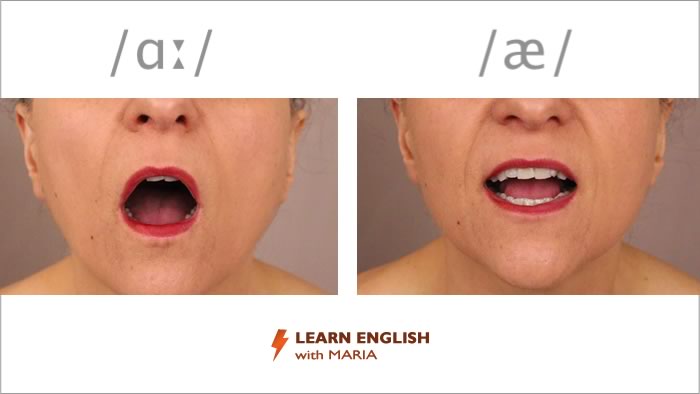
(Note: you can find all the images in this post, plus many more, in my English pronunciation course.)
And that’s also the case with:
- ten – turn
- fill – feel
- fault – fought
- foot – food
Those ten words have ten different vowel sounds, all of them produced with different lip shapes and different tongue positions. Those ten sounds are: /æ/ /a:/ /e/ /ɜ:/ /ɪ/ /i:/ /ɒ/ /ɔ:/ /ʊ/ /u:/
Let’s have a look at them in pairs.
Play Maria’s
free English pronunciation lesson
Pair number 1 – /æ/ /a:/
/æ/ is a short sound. To produce it, the tongue must be fairly low and raising slightly: /æ/

This is the sound in words like: hat, cat, man.
The other sound in this pair is: /a:/
/a:/ is a long sound. To produce it, the tongue must be fairly low and flat: /a:/
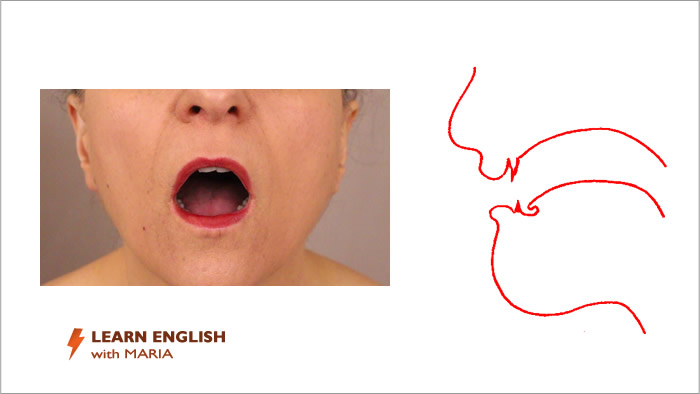
This is the sound in words like: arm, pass, drama.
Let’s compare these two sounds: /æ/ /a:/
The tongue positions for these two sounds are very similar. The main difference is that the middle part is slightly higher in the shorter sound.
But the lip shapes are quite different.
In /a:/, the long sound, the lips are more round.
To practise saying these two sounds, I’m going to play you three pairs of words. The first word in each pair has the short sound /æ/, and the second word has the long sound /a:/.
Repeat these six words after the native speaker. Make sure you say them out loud, as if you were talking to me:
- ant – aunt
- bad – bar
- fat – fast
Say those six words out loud once more.
Pair number 2 – /e/ /ɜ:/
/e/ is a short sound. To produce it, the middle part of the tongue must be halfway up: /e/

This is the sound in words like: set, health, egg.
The other sound in this pair is: /ɜ:/
/ɜ:/ is a long sound. To produce it, the middle part of your tongue must be high: /ɜ:/
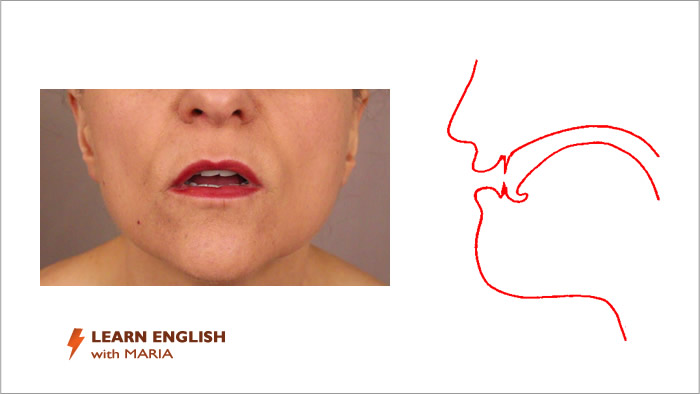
This is the sound in words like: turn, learn, work.
Let’s compare these two sounds: /e/ /ɜ:/
In /ɜ:/, the long sound, the tongue is higher and the lips are less spread.
To practise saying these two sounds, I’m going to play you three pairs of words. The first word in each pair has the short sound /e/, and the second word has the long sound /ɜ:/.
Repeat these six words after the native speaker. Make sure you say them out loud, as if you were talking to me:
- ten – turn
- bed – bird
- head heard
Say those six words out loud once more.
Get Maria’s
English pronunciation course
Pair number 3 – /ɪ/ /i:/
/ɪ/ is a short sound. To produce it, the middle part of the tongue must be high, and the tip behind the parted teeth: /ɪ/
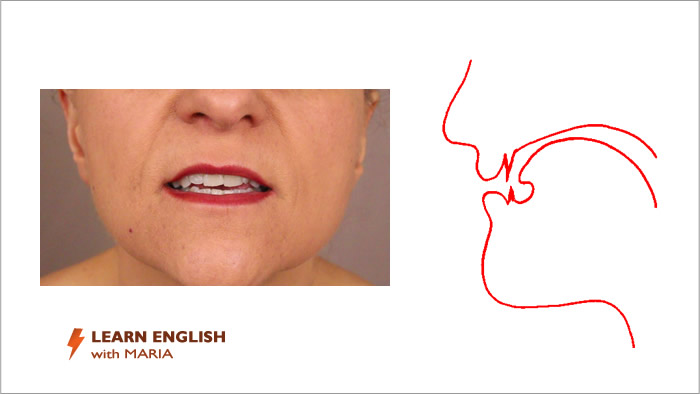
This is the sound in words like: big, image, women.
The other sound in this pair is: /i:/
/i:/ is a long sound. To produce it, the middle part of the tongue must be high, and the tip behind the top front teeth: /i:/
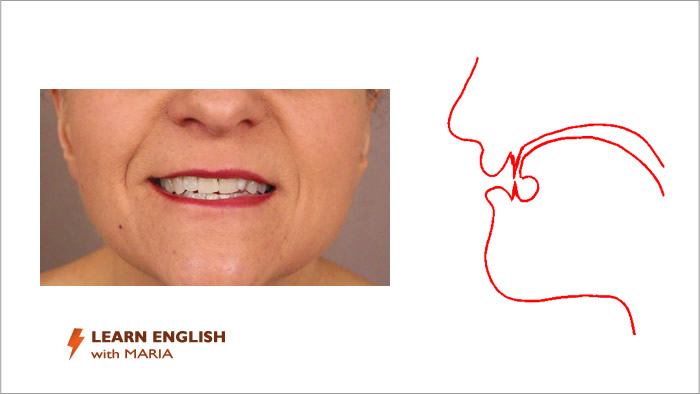
This is the sound in words like: free, legal, police.
Let’s compare these two sounds: /ɪ/ /i:/
In /i:/, the long sound, the tongue is just behind the top front teeth and the lips are more spread.
To practise saying these two sounds, I’m going to play you three pairs of words. The first word in each pair has the short sound /ɪ/, and the second word has the long sound /i:/.
Repeat these six words after the native speaker. Make sure you say them out loud, as if you were talking to me:
- it – eat
- sit – seat
- fill – feel
Say those six words out loud once more.
Pair number 4 – /ɒ/ /ɔ:/
/ɒ/ is a short sound. To produce it, the middle part of the tongue must be less than halfway up, while the tip is behind the bottom front teeth and the back is dropping fast: /ɒ/

This is the sound in words like: not, what, because.
The other sound in this pair is: /ɔ:/
/ɔ:/ is a long sound. To produce it, the middle part of the tongue must be more than halfway up, while the tip is behind the bottom front teeth and the back is fairly high: /ɔ:/
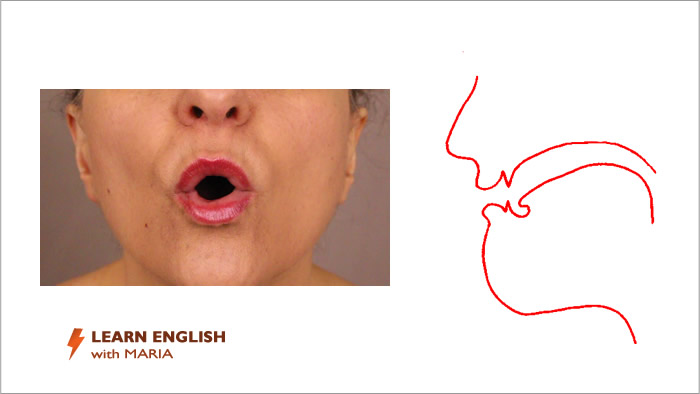
This is the sound in words like: saw, store, thought.
Let’s compare these two sounds: /ɒ/ /ɔ:/
In /ɒ/, the short sound, the back of the tongue is lower and the lips are more open.
To practise saying these two sounds, I’m going to play you three pairs of words. The first word in each pair has the short sound /ɒ/, and the second word has the long sound /ɔ:/.
Repeat these six words after the native speaker. Make sure you say them out loud, as if you were talking to me:
- loss – law
- fault – fought
- pot – pause
Say those six words out loud once more.
Pair number 5 – /ʊ/ /u:/
/ʊ/ is a short sound. To produce it, the middle part of the tongue must be rising, while the tip is behind the bottom front teeth and the back is fairly high: /ʊ/

This is the sound in words like: put, book, could.
The other sound in this pair is: /u:/
/u:/ is a long sound. To produce it, the middle part of the tongue must be more than halfway up, while the tip is behind the bottom front teeth and the back is high.
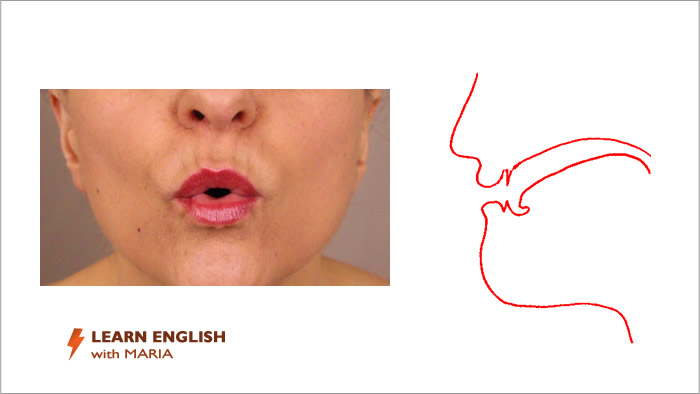
This is the sound in words like: soon, few, fruit.
Let’s compare these two sounds: /ʊ/ /u:/
In /u:/, the long sound, the tongue is higher and the lips are more rounded.
To practise saying these two sounds, I’m going to play you three pairs of words. The first word in each pair has the short sound /ʊ/, and the second word has the long sound /u:/.
Repeat these six words after the native speaker. Make sure you say them out loud, as if you were talking to me:
- foot – food
- wood – wound
- pull – pool
Say those six words out loud once more.
Let’s recap
This is how you say those ten vowel sounds: /æ/, /a:/, /e/, /ɜ:/, /ɪ/, /i:/, /ɒ/, /ɔ:/, /ʊ/, /u:/
Listening exercise
Let’s practise distinguishing those vowel sounds. We’re now going to do an exercise with ten questions.
I’m going to play ten words. Can you tell me whether they have a short or a long vowel sound? I’ll play each word twice, and I’ll give you the answer after you tell me.
Note: you can find all these flashcards, and hundreds more, in my English pronunciation course.
long
short
long
long
short
short
short
long
short
long
Learn the 45 British English sounds
with Maria’s pronunciation course
How did you get on with this exercise?
One of the most effective ways to learn English fast is to repeat an exercise you’ve just done. Far from wasting your time, you’ll quickly reinforce what you’ve learned.
Let’s do this exercise again. I’m going to give you the same ten words, but in a different order. Here they are:
short
long
long
long
short
long
long
short
short
short
